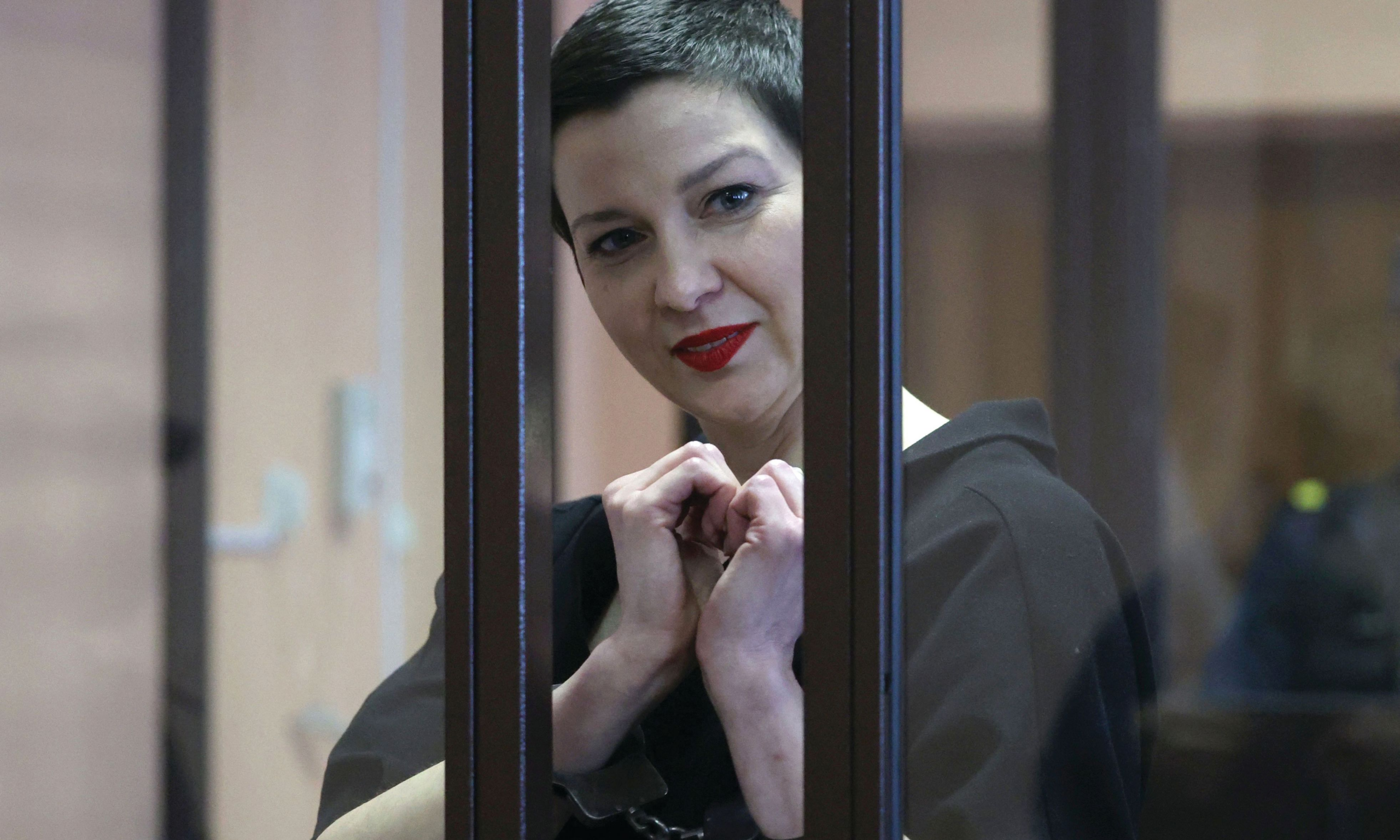Artist, musician and art director Maria Kolesnikova was sentenced to 11 years in prison last month on charges of extremism and “conspiring to seize state power” © Ramil Nasibulin/Belta/AFP via Getty Images
The crackdown on artists in Belarus intensified over the summer with a growing number of cultural figures facing long prison sentences based on unfounded charges as president Alexander Lukashenko continues his clampdown on dissent. Last month, Maria Kolesnikova, a musician and contemporary arts promoter turned political activist, was sentenced to 11 years in prison on charges of extremism and “conspiring to seize state power”.
In snippets of footage from the closed-door trial in Minsk, a smiling Kolesnikova danced, rhythmically banged together her handcuffs and held her hands together in the shape of a heart, a gesture which Russian opposition leader Aleksei Navalny is also known for using in court. “Everything will be fine,” she said.
Kolesnikova, 39, is the art director of OK16, a contemporary arts hub in Minsk that was opened by Belgazprombank. Viktor Babariko, the bank’s former chairman, known for his collection of works by artists such as Marc Chagall and Chaïm Soutine, was also arrested on charges of taking a bribe and money laundering after launching a presidential run against Lukashenko in 2020. He was sentenced in July to 14 years in prison.
Kolesnikova, who was Babariko’s campaign manager before his arrest, ran the opposition campaign headquarters of Svetlana Tikhanovskaya, whose challenge of official election results spurred mass protests against Lukashenko last August. Tikhanovskaya was forced out of Belarus and authorities attempted to expel Kolesnikova last September, but she tore up her passport and turned back, after which she was arrested. Kolesnikova was tried and sentenced with Maxim Znak, a lawyer who, along with Kolesnikova is a member of the opposition’s coordinating council.
Trials, tribulations
Meanwhile, the artist Ales Pushkin is now on trial for “deliberate actions aimed at rehabilitating and justifying Nazism” following an exhibition in which he depicted a post-war Belarusian anti-Soviet guerilla fighter with a machine gun. In June, the Belarusian PEN Centre reported that 39 of 526 people who are recognised as political prisoners in Belarus are culture workers.
Both Belarus and Russia have become increasingly repressive in the past year, with events in one country mirroring and magnifying the other as they move closer to formally integrating. In a meeting at the Kremlin on 9 September, Russian president Vladimir Putin and Lukashenko mapped out the contours of an economic merger. Securing Russia’s sphere of influence and avoiding and preventing Belarus from turning to the West like Ukraine is seen as Putin’s primary motivation, while Lukashenko’s human rights abuses have made Russia his inevitable ally.
St Petersburg is at the centre of the crackdown on independent artists in Russia. On 6 September, a court in the city sentenced Ilya Pershin, a 27-year-old artist, to three years in a prison camp. He is charged with hitting a riot policeman in the chest and knees during pro–Navalny demonstrations on 31 January following the opposition leader’s arrest upon his return to Russia earlier that month. Pershin denies the charges.
He has kept a diary with drawings of his experience in pre-trial detention at St Petersburg’s Kresty prison. In March he wrote: “Today was such a sunny day, that for a second I forgot where I was.”
Belarus: ‘A total dystopian purge’
Jura Shust was born in 1983, in Maladzyechna, Belarus. He first moved to Vilnius, Lithuania, in 2010 to study for his BA, then to Ghent, Belgium, for his MA. He is now based in Berlin, Germany, and had a solo show over the summer at Exile Gallery in Vienna, Austria. He speaks to us about life as an artist under the dictatorship of Alexander Lukashenko.
How was Belarus for an artist?
I think I only truly became an artist abroad since in Belarus it is quite elitist. One can arguably compare the life of a contemporary artist in Belarus to that of a classical poet.
When did it become apparent that it is dangerous for an artist to live under Lukashenko?
I grew up in a family where there were no illusions about Lukashenko. Everything was already clear in the first years of his rule. Videos of the Minsk Spring protests of 1996 left a particularly indelible impression on me. The culture sector was regularly suppressed and kept, as they say, on a short leash. It became apparent that the contemporary art scene in Belarus had to go underground.
How are your artist friends in Belarus getting by right now?
Very few artists have remained in Belarus. Some are in temporary residences abroad and don’t know whether they will be able to return. Those who have stayed are acting with extreme caution since Belarus is in the middle of a total dystopian purge. Thousands of innocent people have been thrown into prison for trying to take control of their lives. The situation right now is such that anyone who is differently minded lives in fear of arrest.
We use cookies to personalise content and ads, to provide social media features and to analyse our traffic. We also share information about your use of our site with our social media, advertising and analytics partners who may combine it with other information that you’ve provided to them or that they’ve collected from your use of their services. Read our Cookie Policy for more information.

